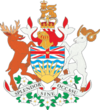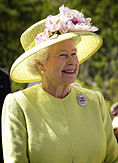- Monarchy in British Columbia
-
Queen in Right of British Columbia Monarchy Provincial/State 
Arms of Her Majesty the Queen in Right of British Columbia
Incumbent:
Elizabeth II
Queen of Canada
since 6 February 1952Style: Her Majesty First monarch: Queen Victoria Formation: 20 July 1871 Residence: Government House, Victoria By the arrangements of the Canadian federation, Canada's monarchy operates in British Columbia as the core of the province's Westminster-style parliamentary democracy.[1] As such, the Crown within British Columbia's jurisdiction is referred to as the Crown in Right of British Columbia,[2] Her Majesty in Right of British Columbia,[3] or the Queen in Right of British Columbia.[4] The Constitution Act, 1867, however, leaves many royal duties in British Columbia specifically assigned to the sovereign's viceroy, the Lieutenant Governor of British Columbia,[1] whose direct participation in governance is limited by the conventional stipulations of constitutional monarchy.[5]
Contents
Constitutional monarchy in British Columbia
The role of the Crown is both legal and practical; it functions in British Columbia in the same way it does in all of Canada's other provinces, being the centre of a constitutional construct in which the institutions of government acting under the sovereign's authority share the power of the whole.[6] It is thus the foundation of the executive, legislative, and judicial branches of the province's government.[7] The Canadian monarch — since 6 February 1952, Queen Elizabeth II — is represented and her duties carried out by the Lieutenant Governor of British Columbia, whose direct participation in governance is limited by the conventional stipulations of constitutional monarchy, with most related powers entrusted for exercise by the elected parliamentarians, the ministers of the Crown generally drawn from amongst them, and the judges and justices of the peace.[5] The Crown today primarily functions as a guarantor of continuous and stable governance and a nonpartisan safeguard against the abuse of power.[5][8][9] This arrangement began with an 1871 Order in Council by Queen Victoria and continued an unbroken line of monarchical government extending back to the late 18th century.[1] However, though British Columbia has a separate government headed by the Queen, as a province, British Columbia is not itself a kingdom.[10]

Government House in Victoria is owned by the sovereign only in her capacity as Queen in Right of British Columbia and used as an official residence by both the lieutenant governor and the sovereign and other members of the Canadian Royal Family will reside there when in British Columbia.[11] Members of the Royal Family have owned property in British Columbia in a private capacity: Princess Margaret, Countess of Snowdon, owned Portland Island, though this was offered by her on permanent loan to the Crown in Right of British Columbia.[12]
Royal associations
Those in the Royal Family perform ceremonial duties when on a tour of the province; the royal persons do not receive any personal income for their service, only the costs associated with the exercise of these obligations are funded by both the Canadian and British Columbia Crowns in their respective councils.[13] Monuments around British Columbia mark some of those visits, while others honour a royal personage or event.[12] Further, British Columbia's monarchical status is illustrated by royal names applied regions, communities, schools, and buildings, many of which may also have a specific history with a member or members of the Royal Family. Associations also exist between the Crown and many private organizations within the province; these may have been founded by a Royal Charter, received a royal prefix, and/or been honoured with the patronage of a member of the Royal Family. Examples include the Royal Vancouver Yacht Club, which, along with the Vancouver Rowing Club and the Vancouver Raquets Club, is under the patronage of Prince Philip, Duke of Edinburgh, and the Royal British Columbia Museum, which received its royal prefix from Queen Elizabeth II in 1987.[14]
The main symbol of the monarchy is the sovereign herself, her image (in portrait or effigy) thus being used to signify government authority.[15] A royal cypher, crown, or the provincial arms (known as the Arms of Her Majesty in right of British Columbia[16]) may also illustrate the monarchy as the locus of authority, without referring to any specific monarch. Additionally, though the monarch does not form a part of the constitutions of British Columbia's honours, they do stem from the Crown as the fount of honour, and so bear on the insignia symbols of the sovereign.
-
The Empress Hotel in Victoria, both of which were named for Queen Victoria
-
Mount Alfred, named in honour of Prince Alfred
-
Princess Louisa Inlet, the name of which remembers Princess Louise, Duchess of Argyll
-
The Royal British Columbia Museum, Victoria
-
The Strait of Georgia, named for King George III
-
King Edward Station on the SkyTrain system in Vancouver
-
Queen Elizabeth Secondary School in Surrey, named for Queen Elizabeth (later the Queen Mother)
-
The Queen Elizabeth Theatre in Vancouver, named for Queen Elizabeth II
History
In 1959, Premier W.A.C. Bennett desired that Queen Elizabeth II read the Speech from the Throne at the opening of a session of the legislature. This request was turned down by the federal Cabinet as being constitutionally impossible.[17]
The Queen was again in British Columbia to mark the centennial of the province's entry into Confederation.[18] In 2002, Elizabeth toured Victoria and Vancouver as part of her Golden Jubilee as Queen of Canada.[19]
See also
References
- ^ a b c Victoria (16 May 1871). British Columbia Terms of Union. 10. Westminster: Queen's Printer. http://www.solon.org/Constitutions/Canada/English/bctu.html. Retrieved 16 June 2009.
- ^ Uukw et al. v. R. In Right of British Columbia and Registrar, Prince Rupert Land Title District, [1988 1 C.N.L.R. 173] (British Columbia Court of Appeal 2 April 1987).
- ^ Elizabeth II (1 April 2005). British Columbia Treaty Commission Act. 2. Victoria: Queen's Printer for British Columbia. http://www.canlii.org/en/ca/laws/stat/sc-1995-c-45/latest/sc-1995-c-45.html. Retrieved 23 June 2009.
- ^ British Columbia v. Imperial Tobacco Canada Ltd., [2005 2 S.C.R. 473, 2005 SCC 49] (Supreme Court of Canada 8 June 2005).
- ^ a b c MacLeod, Kevin S. (2008), A Crown of Maples (1 ed.), Ottawa: Queen's Printer for Canada, p. 16, ISBN 978-0-662-46012-1, http://www.pch.gc.ca/pgm/ceem-cced/fr-rf/crnCdn/crn_mpls-eng.pdf, retrieved 21 June 2009
- ^ Cox, Noel (September 2002). "Black v Chrétien: Suing a Minister of the Crown for Abuse of Power, Misfeasance in Public Office and Negligence". Murdoch University Electronic Journal of Law (Perth: Murdoch University) 9 (3): 12. http://www.murdoch.edu.au/elaw/issues/v9n3/cox93.html. Retrieved 17 May 2009.
- ^ Privy Council Office (2008). Accountable Government: A Guide for Ministers and Ministers of State – 2008. Ottawa: Queen's Printer for Canada. p. 49. ISBN 978-1-100-11096-7. http://www.pco-bcp.gc.ca/index.asp?lang=eng&page=information&sub=publications&doc=ag-gr/2008/ag-gr-eng.htm. Retrieved 17 May 2009.
- ^ Roberts, Edward (2009). "Ensuring Constitutional Wisdom During Unconventional Times". Canadian Parliamentary Review (Ottawa: Commonwealth Parliamentary Association) 23 (1): 15. http://www2.parl.gc.ca/Sites/LOP/Infoparl/32/1/32n1_09e_Roberts.pdf. Retrieved 21 May 2009.
- ^ MacLeod 2008, p. 20
- ^ Forsey, Eugene (31 December 1974). "Crown and Cabinet". In Forsey, Eugene. Freedom and Order: Collected Essays. Toronto: McClelland & Stewart Ltd.. ISBN 978-0771097737.
- ^ MacLeod, p. XIV
- ^ a b British Columbia Archives. "The Legacy". Queen's Printer for British Columbia. http://www.bcarchives.gov.bc.ca/exhibits/jubilee/legacy.htm. Retrieved 25 June 2009.
- ^ Palmer, Sean; Aimers, John (2002), The Cost of Canada's Constitutional Monarchy: $1.10 per Canadian (2 ed.), Toronto: Monarchist League of Canada, archived from the original on 19 June 2008, http://web.archive.org/web/20080619203100/http://www.monarchist.ca/new/docs/costofcrown.html, retrieved 15 May 2009
- ^ Historical Record of Royal British Columbia Museum Corporation, Royal British Columbia Museum, p. 10
- ^ MacKinnon, Frank (1976), The Crown in Canada, Calgary: Glenbow-Alberta Institute, p. 69, ISBN 978-0-7712-1016-7
- ^ Watt, Robert D.. "Ministries > Intergovernmental Relations Secretariat > Official Symbols > The Coat of Arms of British Columbia: A Brief History". Queen's Printer for British Columbia. http://www.protocol.gov.bc.ca/protocol/prgs/symbols/coat_of_arms.htm. Retrieved 8 January 2011.
- ^ Toporoski, Richard (June 2006). "Can the Queen Grant Royal Assent in a Provincial Legislature?: No". Canadian Monarchist News (Toronto: Monarchist League of Canada) Fall-Winter 2005 (24): 19. http://www.monarchist.ca/cmn/2005/AutumnWinter_2005_CMN.pdf. Retrieved 5 July 2009.
- ^ British Columbia Archives. "Chronology of Principal Royal Visits to British Columbia". Queen's Printer for British Columbia. http://www.bcarchives.gov.bc.ca/exhibits/jubilee/chronvisit.htm. Retrieved 25 June 2009.
- ^ "Queen drops puck, raises cheer in arena". CBC. 7 October 2002. http://www.cbc.ca/news/story/2002/10/06/queen_hockey021006.html. Retrieved 24 June 2009.
External links
- British Columbia Archives. "Welcoming the Royals: The Archival Legacy". Queen's Printer for British Columbia. http://www.bcarchives.gov.bc.ca/exhibits/jubilee/intro.htm.
 Canadian monarchy
Canadian monarchyThe Crown Viceroys Constitutional Queen-in-Council · Queen-in-Parliament · Queen-on-the-Bench · Queen's peace · The Canadian Crown and the Canadian Forces · The Canadian Crown and Aboriginal peoplesLegal Ceremonial and symbolic Related Politics of the provinces and territories of Canada Sovereign in the provinces Lieutenant Governors Commissioners Premiers Legislatures Elections OtherCategories:- Monarchy in Canada
- Politics of British Columbia
-
Wikimedia Foundation. 2010.







